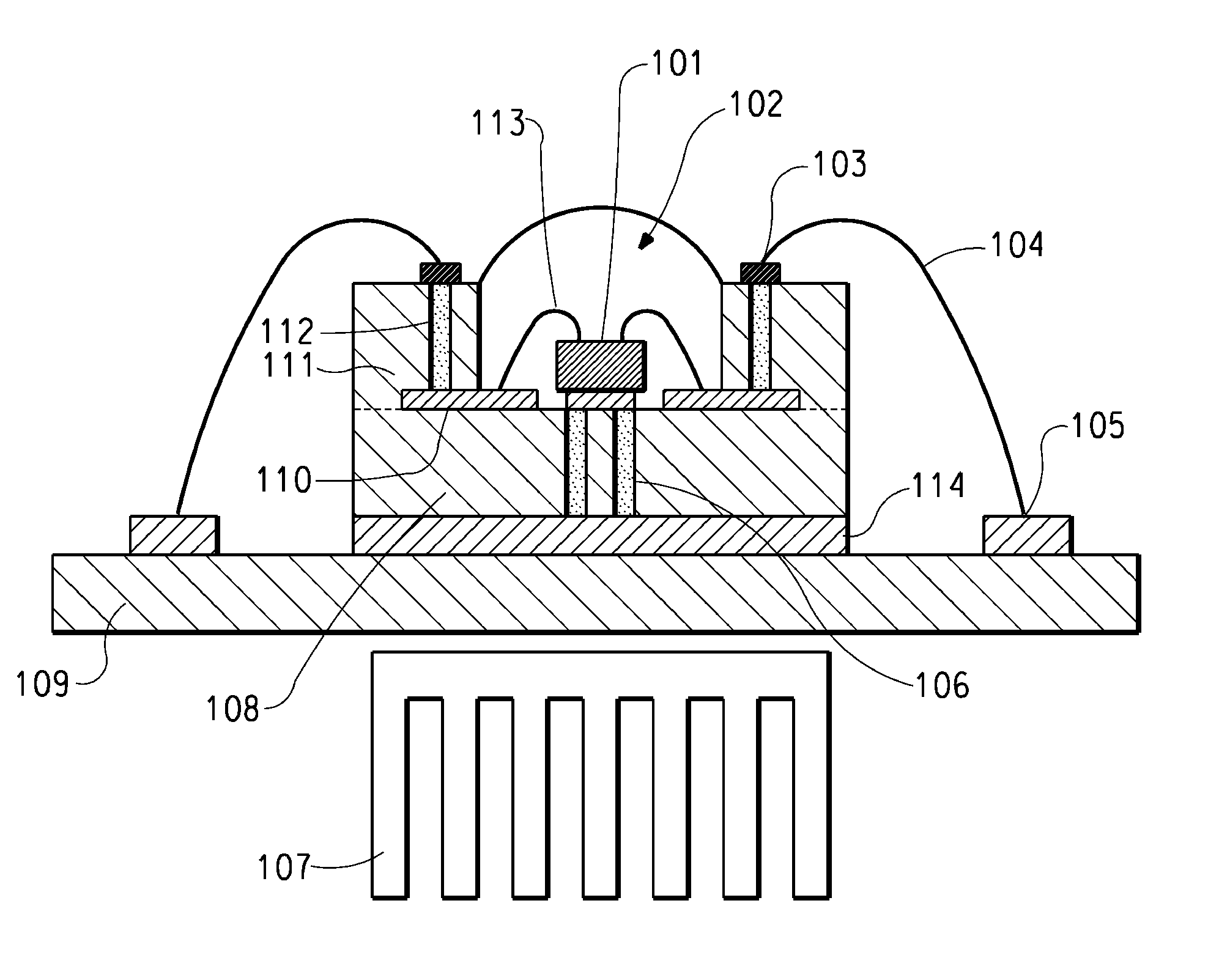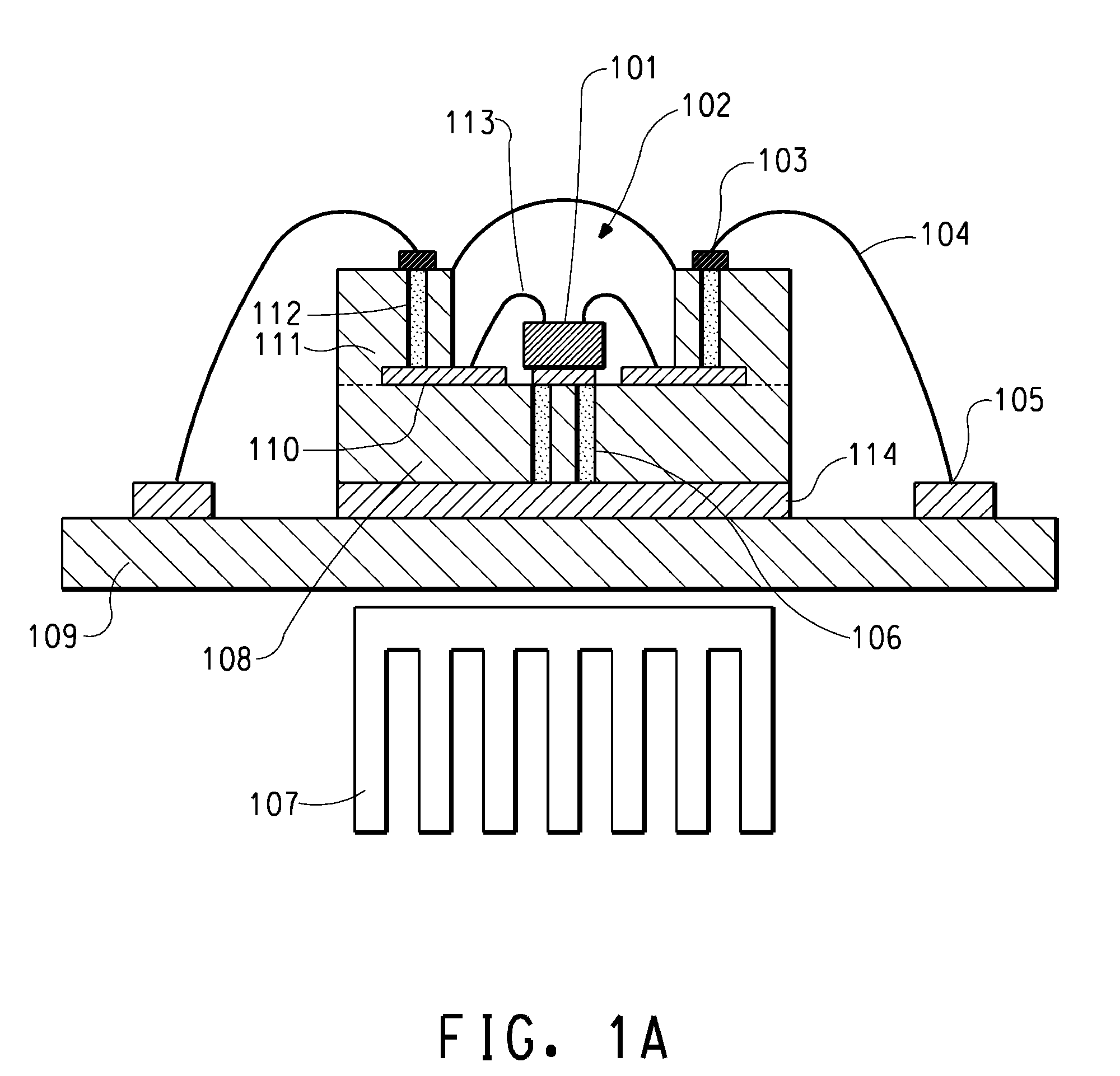Low Temperature Co-Fired Ceramic (LTCC) Tape Compositions, Light-Emitting Diode (LED) Modules, Lighting Devices and Methods of Forming Thereof
a co-fired ceramic and low temperature technology, applied in ceramics, solid-state devices, inorganic insulators, etc., can solve the problems of long device life, long device life, and inability to meet the requirements of ltcc technology, and achieve the effects of reducing the cost of production, and improving the quality of production
- Summary
- Abstract
- Description
- Claims
- Application Information
AI Technical Summary
Benefits of technology
Problems solved by technology
Method used
Image
Examples
example 1
[0109]A four layer LTCC laminate was prepared using the following materials:
[0110]Tape 1, as described above in Table 2 and with the inorganic powder containing 64 volume percent of a glass with the composition in weight percent of glass #5 in Table 1 and 36 volume percent Al2O3. It is noted that the glass #5 contains 17.20 weight % lead oxide. By weight % of the total inorganic composition, glass #5 or alumina is respectively, 55.44%, or 44.56%. It is further noted that inorganic pigments providing white color can also be used to substitute a portion of the alumina, as described in Tape 2 to enhance the light reflectivity of the upper portion of the resultant LTCC chip carrier. The green thickness was 10 mils or 254 rriicrometers.
[0111]After lamination the parts were placed on setters and fired in a conveyer furnace with an air atmosphere where the temperature was increased from room temperature to 850° C. and held for 18 minutes and then allowed to cool back to room temperature th...
example 2
[0112]A four layer LTCC laminate was prepared using the following materials:
[0113]Tape 2, as described above in Table 2 and with the inorganic powder containing 64 volume percent of a glass with the composition in weight percent of glass #5 and 36 volume percent of Al2O3 and TiO2 at a ratio of 10 to 1. By weight % of the total inorganic composition, glass #5, alumina, or titania, is respectively, 55.44%, 40.10%, or 4.46%. The green thickness was 10 mils or 254 micrometers.
[0114]After lamination the parts were placed on setters and fired in a conveyer furnace with an air atmosphere where the temperature was increased from room temperature to 850° C. and held for 18 minutes and then allowed to cool back to room temperature the whole process taking approximately 3 hours and 30 minutes. The fired part was fully densified and free from camber.
example 3
[0115]A four layer LTCC laminate was prepared using the following materials:
[0116]Tape 3, as described above in Table 2 and with the inorganic powder containing 68.7 volume percent of a glass with the composition in weight percent of glass #17 and 31.3 volume percent of Al2O3, glass #17, The weight % composition of frit or alumina is respectively, 58.51%, or 41.49%. The green thickness was 10 mils or 254 micrometers.
[0117]After lamination the parts were placed on setters and fired in a conveyer furnace with an air atmosphere where the temperature was increased from room temperature to 850° C. and held for 18 minutes and then allowed to cool back to room temperature the whole process taking approximately 3 hours and 30 minutes. The fired part was fully densified and free from camber.
[0118]The % light reflection the above blank LTCC substrate at red (650 nm), green (510 nm), or blue (475 nm) light wavelength is, respectively, 82.1%, 81.1 % or 80.9% when measuring the top surface of th...
PUM
| Property | Measurement | Unit |
|---|---|---|
| dominant wavelength | aaaaa | aaaaa |
| dominant wavelength | aaaaa | aaaaa |
| heat dissipation properties | aaaaa | aaaaa |
Abstract
Description
Claims
Application Information
 Login to View More
Login to View More - R&D
- Intellectual Property
- Life Sciences
- Materials
- Tech Scout
- Unparalleled Data Quality
- Higher Quality Content
- 60% Fewer Hallucinations
Browse by: Latest US Patents, China's latest patents, Technical Efficacy Thesaurus, Application Domain, Technology Topic, Popular Technical Reports.
© 2025 PatSnap. All rights reserved.Legal|Privacy policy|Modern Slavery Act Transparency Statement|Sitemap|About US| Contact US: help@patsnap.com



